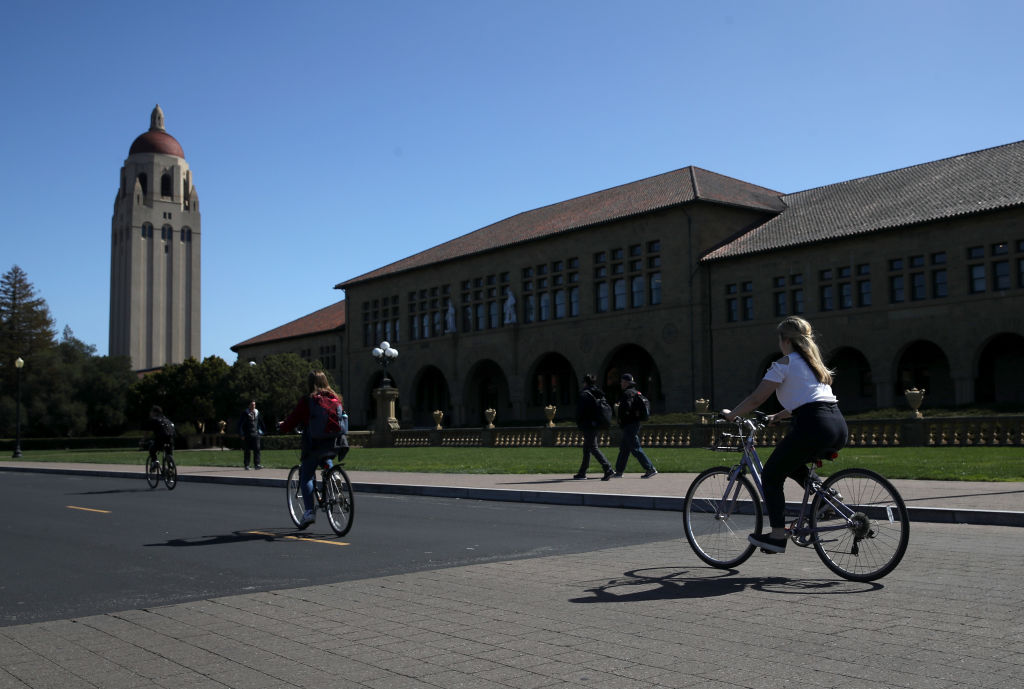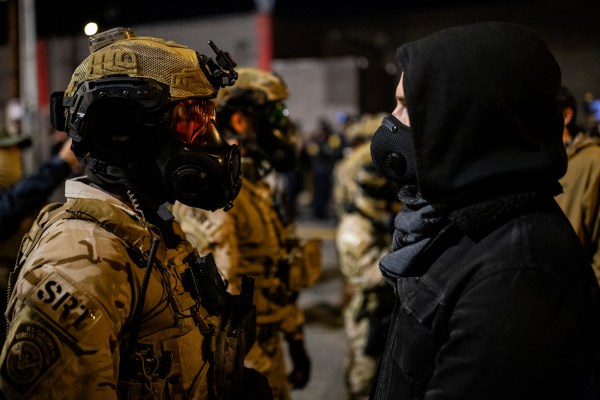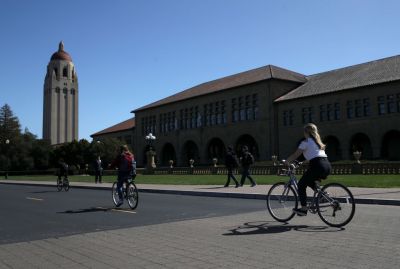When federal judge Kyle Duncan entered a classroom at Stanford Law School last month to speak at the invitation of the Federalist Society, he was greeted by a student shouting, “We hope your daughters get raped.” It did not get better from there. Students heckled him for 11 straight minutes, and the longest he spoke without disturbance was 12 seconds. Students were vulgar, asking about Duncan’s sex life in graphic terms. And they were sadistic: Listen to the audio and decide for yourself whether they were enjoying the humiliation they inflicted.
Duncan, a conservative judge who sits on the 5th Circuit Court of Appeals, broke from his prepared remarks seven minutes in to lament that “in this school, the inmates have gotten control of the asylum.” But he got his metaphor wrong.
He eventually asked for an administrator to intervene, only to discover one had been sitting there the whole time. Tirien Steinbach, identifying herself as an associate dean, took the podium with her own prepared remarks and denounced Duncan. She said that it was uncomfortable to tell him, but his work had caused harm. She asked, memorably, “Is the juice worth the squeeze?” (The “juice” being his talk; the “squeeze” being the pain caused by his mere presence.)
Steinbach’s treatment of Duncan unveiled an ugly truth about why shoutdowns like this have become so prevalent: It’s not that campuses are overrun by out-of-control students prone to anti-social behavior. It’s that administrators are still very much in control and creating an environment ripe for these results.
The hecklers at Stanford were not an indecent mob that had wrested control of the school from its leaders. Even more, these students aren’t the vulgar and sadistic lot they played in front of Duncan. We’ve seen perfectly decent people turn to sadistic group behavior before. In fact, we’ve seen it before at Stanford.
Casting students as inmates in control of an asylum is the wrong way to understand what’s happening on college campuses. If we want to understand what’s really happening—and how to make it stop—we should pay attention to what happened at Stanford a half-century ago. The better analogy is the Stanford Prison Experiment.
In the summer of 1971, Stanford psychology professor Philip Zimbardo launched a planned two-week prison simulation. He was interested in “the ease with which ordinary people could be led to engage in anti-social acts by putting them in situations where they felt anonymous or where they could perceive of others in ways that made them less than human, as enemies or objects.”
The research team chose 24 male students from a pool of 75 applicants, selecting those whom they judged “most stable (physically and mentally), most mature, and least involved in anti-social behaviors.” Then they randomly assigned the students roles—half as guards, half as prisoners. The guards wore matching uniforms, carried wooden batons, and were given mirrored sunglasses to give them a sense of status and anonymity. They referred to prisoners by the numbers on their uniforms rather than by name, a way of diminishing the prisoners’ individuality. Their instructions were simple: “Maintain the reasonable degree of order within the prison necessary for its effective functioning.”
By the second day, guards were harassing, humiliating, and intimidating their prisoners. They removed prisoners’ clothes, took away their mattresses, required them to do pushups, and forced them to relieve themselves in buckets. They turned prisoners against each other with psychological ploys. Even as one student was being removed from the experiment after showing signs of mental breakdown, the guards persuaded other prisoners to shame him for leaving.
Another psychologist visited on day five to observe. After she watched guards leading prisoners through the hallway with paper bags over their heads and chains connecting their feet, she told Zimbardo what he was doing was terrible. He stopped the experiment the next day, more than a week ahead of schedule.
In just a few days, stable, mature Stanford students transformed into merciless bullies. Years later, the most abusive of the guards, Dave Eshelman, acknowledged that he had created a persona for the study. He set out to see how far he could push and how much abuse the prisoners would take before someone backed him off. “But the other guards didn’t stop me,” he said. “They seemed to join in. They were taking my lead. Not a single guard said, ‘I don’t think we should do this.’”
Eshelman’s conscious creation of a persona illuminates how quickly people are willing and able to play a character given the right setting. His reflections also reveal how far people will push the boundaries of social decency when they believe no one will stop them: “When you have little or no supervision as to what you’re doing, and no one steps in and says, ‘Hey, you can’t do this’—things just keep escalating.”
While the guards in the Stanford Prison Experiment may have felt that they had little supervision, they were never in charge. Zimbardo was. But by his own account, his perception of the situation had blurred: “By the third day I was sleeping in my office. I had become the superintendent of the Stanford county jail. That was who I was: I’m not the researcher at all.”
The Stanford Prison Experiment’s fame derives not only from its participants’ shocking behavior but also from questions about whether it should have ever been conducted. In its wake, the ethical rules for studies involving human subjects have become much more stringent.
The most common reaction to the Stanford Law School meltdown and other similar ones is to ask what’s gone wrong with the kids these days.
See the subtitle of a USA Today opinion piece: “The coddled students at Stanford Law School came off as spoiled brats unable to engage in a civil debate with a federal judge—alarming considering the profession they're pursuing.”
Or see Whoopi Goldberg’s criticism of the students on The View: “So maybe all the snowflakes in the world need to get over the fact that people are going to disagree with them.”
The responses to last year’s fiascos at Yale Law School were similar.
Yale’s problems began that fall, in an event that came to be known as Trap House-gate. Dean of Students Ellen Cosgrove and Diversity Director Yaseen Eldik pressured a student to apologize for sending an email in which he jokingly referred to his apartment by using slang for a drug den, saying that others had been “triggered” by his association with the Federalist Society. A Washington Post column about the controversy noted that Yale students “may be among the best and brightest, but they also need to do some growing up.” Months later, students disrupted a bipartisan free speech panel featuring Kristen Waggoner, a Supreme Court litigator for the conservative Alliance Defending Freedom (ADF), and Monica Miller, from the progressive American Humanist Association. Yale Law professor Kate Stith told the disruptive students to “grow up.” They proceeded into the hallway, where they shrieked, banged on the walls, and sang “Happy Birthday” at the top of their lungs. (No one afterward could identify whose birthday they were celebrating with such fervor.) Cosgrove was in the room throughout. Eldik accompanied the protestors into the hallway.
Events like these prompt questions about whether these students could possibly handle the real world. If they are so incapable of hearing views they dislike, how will they be able to comport themselves as judicial clerks, litigators, and possibly even judges? Don’t worry: They’ll be able to do those things quite easily.
Some of the students who belted out “Happy Birthday” in the Yale Law School hallways went on just months later to clerk for federal judges, take jobs at top law firms across the nation, or work in the Department of Justice. Many of the Stanford Law School students who couldn’t stand the thought of having a disagreeable federal judge on campus will go on to similar jobs just a few months from now. And all of them will find ways to interact with their opponents that don’t involve shrieking or heckling.
That’s because these students are playing roles right now. They’re like those well-adjusted college students who became ruthless prison guards overnight in the Stanford Prison Experiment. And they can snap out of these roles as easily as they assume them.
I know this. I’m a second-year law student at Yale. I was at the disrupted ADF event last year. I watched with some disbelief as classmates behaved in bizarre and inappropriate ways. But I’ve also had lunches, coffees, dinners, and cocktails with many of those same classmates, and I don’t think they’re the people they appear to be in the media. They’re funny, thoughtful, brilliant people with deep convictions. And in settings where they’re no longer playing the role of “outraged law student,” they’re willing to have a reasonable conversation about different ideas and beliefs. The problem on campus today isn’t immature and out-of-control students. The problem is that too many of our institutions of higher learning are running a big Stanford Prison Experiment.
In Zimbardo’s prison study, he assigned authoritarian roles to a group of students. Then he gave them a common enemy and dehumanized that enemy. In doing so, he lost himself in the project. He ceased to be the “adult-in-the-room” and became instead the superintendent of the jail. All of the same is happening on our campuses. Administrators have the power to undo it all.
First, consider the roles we’re assigning students. I’ve heard several classmates talk about holding others “accountable for their views.” This kind of accountability seems to stretch to who should be allowed on campus, what professors should say and do, and what other students should believe. When an objectionable person comes to campus, students feel authorized to shout that person down. Students may have the power to get professors who offend them fired, like the Minnesota professor dismissed for showing a picture of the prophet Mohammed—even after she had given multiple warnings for anyone who may be offended. After the Dobbs decision leaked last spring, a Yale Law School student asked why Federalist Society members were able to walk the school’s halls without “daily confrontation.”
We’ve given students the role of ideological prison guard on campus. This can make everyone else a thought and speech prisoner. Faculty and students alike must guard against any missteps that could attract unwelcome attention from the guards. As a coordinator of several speaker events, I’ve had speakers with mainstream views express reluctance about coming to our campus for fear of the students. That should not be.
We should also ask if it’s fair to the students to put them in the role of the prison guards, even if they want that role. Yes, they can snap out of it when they go on to clerk for federal judges or argue in front of them. But just as we might ask if the experiment did some long-term psychological damage to the guards in the Stanford Prison Experiment (to say nothing of the prisoners), we might ask if we’re doing the same harm to these students by letting them assume these roles now.
Gladly, there are signs of positive change.
Yale Law School has taken steps in a new direction. The administration made clear to incoming students that it expects them to behave respectfully and treat others with civility. When Kristen Waggoner of ADF returned this spring, the administration worked with student groups on how to respond. It ensured that several respected faculty members would attend to represent competing views. The event went off without incident.
Another controversial speaker, former Texas Solicitor General Jonathan Mitchell, came to campus and debated Yale’s most fiery professor, Akhil Amar. During a vigorous exchange, Amar turned to the packed room and said, “Do you see what you get when you actually let people talk?” The crowd applauded. The event got less attention than it might have had it been shouted down. But it was much more productive for the actual purposes of a university.
And at Stanford Law School, Dean Jenny Martinez released a 10-page letter that focused on the roles of students and administrators at a university. She reminded her students they were “lawyers in training” who would be “held to higher standards of professional conduct and interaction with one another.” In a bolded line, she announced that “the role of any administrators present [at events] will be to ensure that university rules on disruption of events will be followed.” It’s long past time that students and university administrators return to these understandings of their roles.
Zimbardo’s theory was that people are easier to mistreat when viewed as evil and undeserving of humane treatment. That theory proved true then, and it’s proving true today, too. This problem is hardly limited to college campuses, but higher learning institutions have an easier corrective available than most other settings.
Consider the dehumanization problem first. We are increasingly coming to believe that people with different ideologies than our own are evil. In a recent Pew survey, most Democrats and Republicans said they believe that members of the other political party are more dishonest and immoral, and less intelligent than other Americans. Only seven years ago, none of these were majority positions. No wonder instances like that at Stanford are becoming more prevalent. Those law students didn’t just believe that Duncan’s beliefs were wrong; they believed that he was evil and thus deserving of abusive treatment.
Too many universities are reinforcing the narrative that certain ideologies—not just fringe ideologies, but those held by one of our two major political parties—are nearly intolerable.
Universities could counter this by hiring ideologically diverse professors, both to expose students to the best ideas from all sides and to signal that they value ideological diversity. Instead, many institutions almost entirely lock out conservative professors and thus reinforce the idea that certain ideologies are not welcome. Take Yale Law School. The last conservative public law professor left the school more than 40 years ago. Since then, not a single constitutional law professor at the school has been right of center. For faculty members embarrassed when their schools make the news or fearful of students who want to enforce ideological purity on campus, the best step would be to advocate for more ideological diversity within their ranks.
Finally, remember that while the Stanford Prison Experiment focused on the students, Zimbardo was always in charge. The prison guards may have felt like there was “little or no supervision,” but Zimbardo was watching the whole time. The same is true on campuses. At both the Stanford and Yale protests, the administrators were still in the room. The question is why they keep letting this bad experiment continue.
The Stanford incident gives some indication. For all the videos we’ve seen of outraged students on campuses, Tirien Steinbach was the first outraged administrator we’ve seen take center stage. Steinbach’s behavior shows that Stanford’s problem wasn’t out-of-control students without supervision. Instead, their supervisor was prodding them on. She had lost her objectivity as an administrator. She had become the superintendent of the new Stanford prison.
It took an outsider coming to observe the prison experiment to snap Zimbardo back to reality. That may be what happens with our campuses as well. Many students at Yale resented having our problems covered by outside media. They argued that these issues should be resolved internally. But sometimes things like this need to be exposed to outsiders to be recognized for what they are. Within the walls of Yale or Stanford Law School, behavior like this can seem normal. We snap back to reality only when the behavior is exposed to the outside world.
Ellen Cosgrove has conveniently retired, and the remaining administrators have worked hard to ensure that last year’s embarrassments don’t happen again. And there is even talk about Yale hiring a conservative constitutional law scholar. That will be worth watching. It could be the next sign that Yale is leading the way to end this bad experiment. Perhaps Stanford and others will follow suit.
Correction, April 24, 2023: This piece stated incorrectly that Diversity Director Yaseen Eldik left Yale. He is still listed in the Yale directory.






Please note that we at The Dispatch hold ourselves, our work, and our commenters to a higher standard than other places on the internet. We welcome comments that foster genuine debate or discussion—including comments critical of us or our work—but responses that include ad hominem attacks on fellow Dispatch members or are intended to stoke fear and anger may be moderated.
With your membership, you only have the ability to comment on The Morning Dispatch articles. Consider upgrading to join the conversation everywhere.